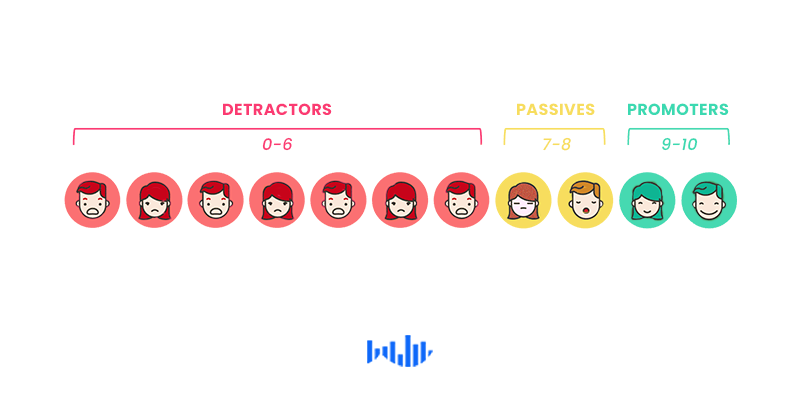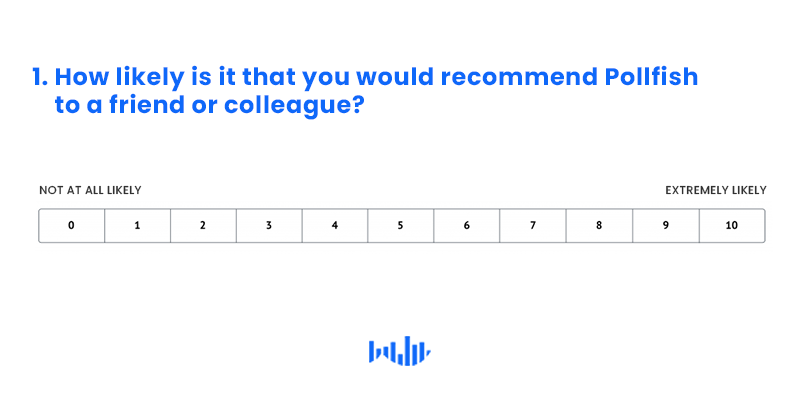Diving Into the Net Promoter Score (NPS) Survey

The Net Promoter Score (NPS) survey is one of the most prominent customer satisfaction surveys. Based on its eponymous score, this survey measures one of the most critical aspects of customer satisfaction: loyalty.
While brand awareness and product / experience satisfaction are invaluable for any business, loyalty is the only guaranteeing factor that assures your customers will return to your brand for future purchases. As a matter of fact, 43% of customers spend more on a brand that they’re loyal to.
Brands should thus keep track of their NPS score, as it is one of the top indicators of customer loyalty. The best way to do so is by running NPS surveys. This article will take a deep dive into this survey type and guide you on several best practices.
Defining the Net Promoter Score
As its name indicates, the Net Promoter Score survey is a survey based on its titular Net Promoter Score. The score is a key customer satisfaction metric, as it reveals how likely a customer is to recommend a product or company to a friend or colleague.
The score is derived by asking just one question, known as the Ultimate Question in relation to the above. The responder answers the question using a scale of 0-10. 0-6 is the low end of the scale, denoting negative sentiment towards the brand and thus a low chance of receiving a customer’s recommendation.
Conversely, 9-10 is the higher end of the scale, signifying a high chance of customer satisfaction and recommendation of the company. 7-8, although they appear on the higher end, are known to be the mid-range.
This scale is only one aspect of the NPS, as it requires using respondents’ combined answers to find the score in a particular study. Thus, an NPS survey is the vehicle used in obtaining and enriching this score.
Let’s observe the nuances of the NPS score and how to calculate it.
How to Calculate the NPS and its Numerical Significance
Delving into the specifics of this score, you’ll find that the numbers represent more than just the “not likely” and “extremely likely” points of view.
On the contrary, the NPS score designates several types of customers based on their answers: the detractors, the passives and the promoters.
It also requires a calculation, as the respondents’ answer itself does not represent the final score. First, you’ll need to know the customer classification in the NPS, which is based on the answers the respondents give. Here is the numerical significance for each answer range:

- 0-6: The Detractors: The most unlikely group to recommend your company or product.
- Unlikely to stay on your website for long or make repeat purchases
Tend to be naysayers, which means they can intentionally discourage other customers from buying from your brand. - Can spread negative opinions about your brand on social media, forums or word of mouth.
- 7-8: The Passives: The somewhat satisfied group of customers susceptible to buying from your competitors.
- Won’t actively recommend your brand, yet aren’t likely to harm it with negative feedback.
- Not used in the NPS calculation.
- Close to being promoters (especially if they respond with an 8)
- Opportune for brands to study and nurture this group, as they are the easiest to convert to promoters.
- 9-10: The Promoters: The most loyal customers who make continuous purchases from your brand and refer others to it.
- Most likely to act as brand ambassadors and augment your brand’s reputation.
- Most responsible for a company’s growth.
- Increase referrals, thereby increasing brand awareness.
You will need to understand these to calculate the Net Promoter Score. Here is how to do so:
- Subtract the percentage of Detractors from the percentage of Promoters.
- For example, if 15% of respondents are Detractors, 20% are Passives and 60% are Promoters, your NPS score would be 60-15 = 45.
- The NPS= 45, as it is always represented as a digit, not a percentage.
- A higher NPS score points to a larger amount of promoters, which is most ideal.
The NPS Survey Measures & Correlates with Growth
A Net Promoter Score survey puts the score to greater use by providing it with context. As such, this type of survey does not merely ask the Ultimate Question; it can ask more for a more lucid context.
This is to say that despite the NPS being the bulk of an NPS survey, it is just that: a part of it but not its entirety. This survey is capable of not only measuring growth but it has proven to correlate with it.
According to Bain & Company, which devised the Net Promoter System, the score can determine growth. Bain conducted a study on the correlation between the NPS and organic growth, measuring this score among business competitors in different industries
Bain concluded that the NPS correlated with 20%-60% of organic growth among these competitors. What’s more is that Net Promoter Score leaders went on to outgrow their competitors by more than twice.
This proves the urgency of tracking one’s NPS and a Net Promoter Score survey helps do just that. This score will enlighten your business on how to improve on several fronts. To understand how you must understand the other questions and facets of an NPS survey.
The Components of an NPS Survey & How they Provide Key Insights

Aside from asking the Ultimate Question, there are a few other capabilities you can configure to fortify your customer satisfaction measurement. These will provide much more context than a number (the NPS) can alone.
Here are some other ways your business can benefit from a Net Promoter Score survey based on its components.
- You can set up the NPS survey to measure virtually anything instead of simply obtaining a general NPS for your brand. You can use it measure:
- Products
- Interactions with representatives
- UX
- Brick and mortar stores & more
- If looking for insight into something specific, you can implement the NPS survey in various parts of the customer journey, such as:
- The homepage
- A landing page
- A product page
- At checkout
- Post checkout/purchase
- You can perform market segmentation by using demographics as part of your survey. This will help you create groupings of respondent answers based on their demography. You can thus make educated deductions on how your NPS answers correlate with different demographics.
- The added questions. You can use the survey to extract key contextual information that a score alone wouldn’t grant you, such as:
- Finding the exact reason behind a respondent’s number. For example:
- What are the main reasons for the score you gave us?
- What makes you feel this way?
- Improving customer and user experience. For example:
- What can Pollfish do to improve your experience?
- How can we improve this product, interaction, etc?
- Following up with the respondents to learn more about their concerns on a more granular level. For example:
- Can we follow up with you about your responses?
- Can we follow up with you to see how we can improve your experience?
- Finding the exact reason behind a respondent’s number. For example:
Transactional vs Relational NPS Surveys
Now that we’ve established and elucidated the utility and importance of Net Promoter Score surveys, let’s examine the two main types of NPS surveys.
These surveys are classified as relational and transactional NPS surveys. They are categorized based on both their frequency and purpose of deployment.
- Relational NPS Surveys:
- Deployed periodically, such as every quarter, annually or monthly.
- Designed to keep regular track of customer sentiment, find patterns and detect changes in attitudes toward your brand overall.
- Provide “health check-ins” on customers as a way to measure success.
- Transactional NPS Surveys:
- Distributed after a customer interacted with your company (ex: post purchases or conversation with a representative).
- Used to understand customer satisfaction in more depth.
- Based on specific topics.
The success of your brand depends on using both of these types of surveys to fully comprehend your customer loyalty. If you rely on sending out various transactional NPS surveys, then you ought to adjust your relational surveys to a lesser frequency.
If you rarely deploy transactional surveys, you should dispense more frequent relational surveys. To find the correct balance of using both, examine all of your survey feedback. Look for things you find to be missing and once you do, determine which type of survey these concerns best fall under.
Customer Loyalty and Long-Term Business Success
The main insight you can glean from Net Promoter Score surveys is how loyal your costumes are, and of course, how many customers can damage your reputation.
Through more detailed questions, you can pinpoint the reasons behind your customers’ satisfaction or dissatisfaction with your company as a whole or a particular component.
This allows you to innovate better, augment your offerings and fix any bugs (whether it’s with an online experience, a salesperson or any other feature). As mentioned above briefly, one of the benefits of this type of survey is its versatility; it can be used to measure satisfaction with just about anything.
The goal is to use the insights you’ve acquired through this survey to gain loyal customers, the kinds who transcend the notion of “customer,” by becoming brand evangelists.
Frequently asked questions
What is the Net Promoter Score (NPS) survey?
The Net Promoter Score (NPS) survey is a type of survey that seeks to understand customer satisfaction by measuring how likely it is that a customer will recommend a product, company, or service to a friend or associate.
How many questions are included in the NPS survey?
The NPS survey typically requires just one question, which asks: “How likely are you to recommend [company, product, or service name] to a friend or colleague?” Researchers can expand on it, so it resembles a full-fledged survey by adding more relevant questions.
How is the Net Promoter Score calculated?
The Net Promoter Score is calculated by subtracting the percentage of Detractors from the percentage of Promoters. Respondents who gave a Passive response are not included in the calculation. The NPS is then described as a number rather than a percentage.
How can the NPS predict growth?
Studies have demonstrated a correlation between a high NPS and organic growth. Those who achieved high Net Promoter Scores tended to outpace their competitors in organic growth.
What types of businesses can benefit from conducting a NPS survey?
All types of businesses can benefit from using an NPS survey. Brick and mortar stores and online shops can benefit equally, as can those selling any type of product or service.
Pollfish Marketing Team
Ready to Try Pollfish?
Create your survey with AI, target high-quality respondents starting at $0.95 per complete, and start getting results in just minutes in real-time. From running a simple product concept survey to managing a constant stream of trackers for dozens of clients in dozens of countries, we’ve got you.
